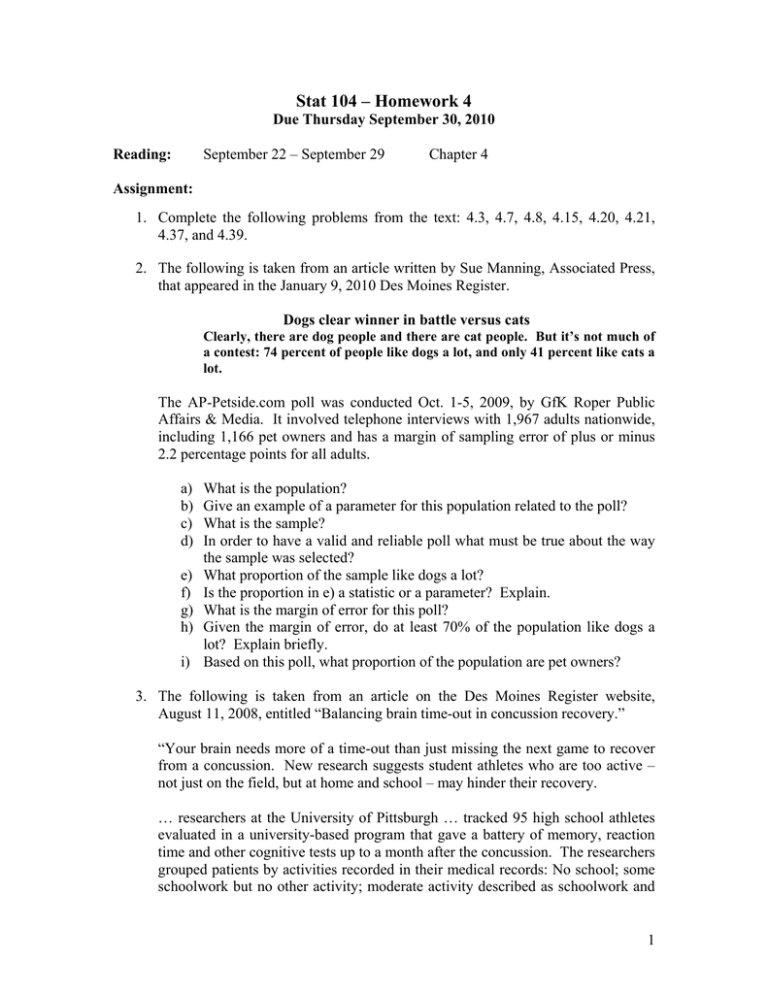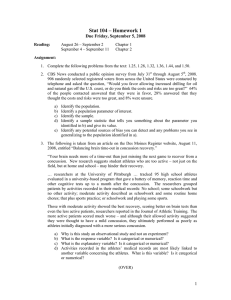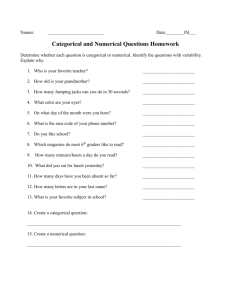Stat 104 – Homework 4
advertisement

Stat 104 – Homework 4 Due Thursday September 30, 2010 Reading: September 22 – September 29 Chapter 4 Assignment: 1. Complete the following problems from the text: 4.3, 4.7, 4.8, 4.15, 4.20, 4.21, 4.37, and 4.39. 2. The following is taken from an article written by Sue Manning, Associated Press, that appeared in the January 9, 2010 Des Moines Register. Dogs clear winner in battle versus cats Clearly, there are dog people and there are cat people. But it’s not much of a contest: 74 percent of people like dogs a lot, and only 41 percent like cats a lot. The AP-Petside.com poll was conducted Oct. 1-5, 2009, by GfK Roper Public Affairs & Media. It involved telephone interviews with 1,967 adults nationwide, including 1,166 pet owners and has a margin of sampling error of plus or minus 2.2 percentage points for all adults. a) b) c) d) e) f) g) h) i) What is the population? Give an example of a parameter for this population related to the poll? What is the sample? In order to have a valid and reliable poll what must be true about the way the sample was selected? What proportion of the sample like dogs a lot? Is the proportion in e) a statistic or a parameter? Explain. What is the margin of error for this poll? Given the margin of error, do at least 70% of the population like dogs a lot? Explain briefly. Based on this poll, what proportion of the population are pet owners? 3. The following is taken from an article on the Des Moines Register website, August 11, 2008, entitled “Balancing brain time-out in concussion recovery.” “Your brain needs more of a time-out than just missing the next game to recover from a concussion. New research suggests student athletes who are too active – not just on the field, but at home and school – may hinder their recovery. … researchers at the University of Pittsburgh … tracked 95 high school athletes evaluated in a university-based program that gave a battery of memory, reaction time and other cognitive tests up to a month after the concussion. The researchers grouped patients by activities recorded in their medical records: No school; some schoolwork but no other activity; moderate activity described as schoolwork and 1 some routine home chores; that plus sports practice; or schoolwork and playing some sports. Those with moderate activity showed the best recovery, scoring better on brain tests than even the less active patients, researchers reported in the Journal of Athletic Training. The more active patients scored much worse – and although their allowed activity suggested they were thought to have a mild concussion, they ultimately performed as poorly as athletes initially diagnosed with a more serious concussion. a) b) c) d) Why is this study an observational study and not an experiment? What is the response variable? Is it categorical or numerical? What is the explanatory variable? Is it categorical or numerical? Activities recorded in the athletes’ medical records are most likely linked to another variable concerning the athletes. What is this variable? Is it categorical or numerical? 4. A swine feeding study was performed by G. L. Cromwell, Professor, Swine Nutrition, University of Kentucky. The study involved replacing corn and soybean meal with light wheat middlings, a byproduct of the wheat milling industry. Light wheat middlings are higher in fiber, protein and fat when compared with the entire wheat kernel. Pigs were randomly assigned to diets where 0, 10, 20, 40 or 60% of the corn-soybean meal diet was replaced with wheat middlings. All diets contained the same level of lysine during the growing (0.80% lysine) and finishing (0.65% lysine) period. Below are summaries of growth of pigs for the study. Light Wheat Middlings (%) Average daily gain, lb 0 1.81 10 1.78 20 1.72 40 1.70 60 1.59 a) Why is this study an experiment and not an observational study? Explain briefly. b) Identify the response variable. What type of variable is this? Qualitative/Categorical or Quantitative/Numerical? c) What are the treatments? Be specific. d) Identify an outside variable that was controlled. How was it controlled? e) Is there a control group in this experiment? Explain briefly. f) Summarize the results of the study. Based on the summaries of the study what is the effect of adding light wheat middlings to a pig’s diet on the growth of the pig? 2





